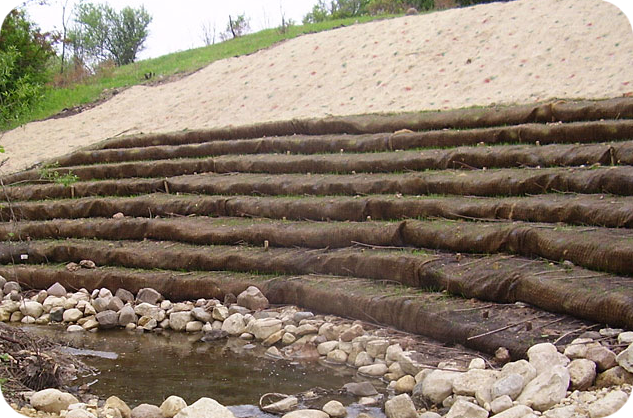Application: Bridges, canals, coastlines, culverts and drains, dykes, embankments, floodgates, markets, roads and footpaths, stormwater outfall
Description: A vegetated geotextile consists of alternating layers of live branch cuttings and compacted soil with erosion control fabric (natural or synthetic geotextile) wrapped around each soil layer. The geotextile is secured by tucking it into the slope, keeping the soil in place. Live cuttings are placed between the geogrids, and a root structure is established to bind the soil within and behind the geogrids. The toe of the bank is stabilized by layers of rock on top of the soil layers. The live branch cuttings serve several practical purposes. They act as a buffer to reduce wave energy and shear stress at the face of the wall. In addition, having the branch cuttings present before the completion of the wall enables the vegetation to grow as rapidly as possible. Finally, once established the branches serve to bind the geogrids together and provide a root structure behind the wall, attaching it more securely to the shore.
Contribution to climate resilience: Vegetated geotextiles reduce erosion caused by rainfall as it covers and protects the soil surface and provides soil reinforcement through the vegetation roots. The velocity of run-off is slowed down and infiltration is increased. This increases the resilience of roadside slopes to extreme climatic events. Their effectiveness increases with time as the vegetation becomes fully established. Because they are constructed with local labour and materials, they require less energy to produce, are far more sustainable, and can often be applied in a quicker timeframe than traditional civil engineering works.
Supplementary sources of information:
http://www.ctre.iastate.edu/erosion/manuals/streambank/vegetated_geogrids.pdf
http://projects.geosyntec.com/npsmanual/Fact%20Sheets/Vegetated%20Geogrids.pdf
http://www.ctre.iastate.edu/erosion/manuals/streambank_erosion.pdf
http://dewprojects.countyofkane.org/dixieBriggsFromm/gallery.asp
This resilience-building measure is sourced from the Water Resource Adaptation Guide (2019) published by the National Council for Sustainable Development at the Ministry of Environment in Cambodia. The full Guide is available to download at URL https://ncsd.moe.gov.kh/sites/default/files/2019-10/Water%20Resources%20Adaptation%20Guide_March%202019_En.pdf


